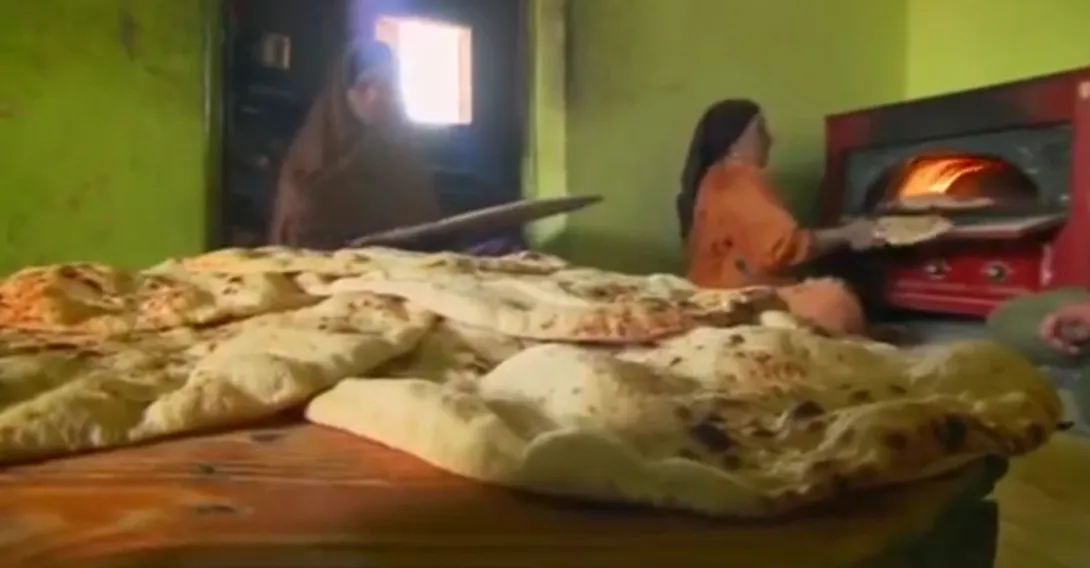
I have been trying to make a decent flatbread that would go with eastern dishes, I have tried lots of recipes with none of them coming out quite the way I wanted. I recently watched "A Cook Abroad" and in it an Egyptian woman made a flatbread that looked exactly like what I wanted to achieve. I have included photos of what it is I want to make.
Please can you guys help me
Liam
The programme is on youtube it's worth a watch, but the specific time is at 24:00
https://m.youtube.com/watch?v=q9X3zmKAWQA
i have some screen shots to help make it clearer
I will be watching here for ideas and results. Good luck.
Hi,
I think I can help you with that. This bread they're making in Fayoum is the same bread like we have in Cairo, only bigger. The dough is very basic, just flour, water, salt and yeast. The main difference however is the wheat bran. This is the most important ingredient.
The idea behind this bread is quite fascinating, to me at least. You see when you have a yeast-leavened dough and cut up in small pieces then roll it flat, all the small gas pockets are somewhat lined up next to each other. Then you take this dough and bake it in a screaming hot oven like the ones you see in this show. As is true with any yeasted bread, oven spring starts as soon as the dough's temperature starts to increase. But, the main distinction with this bread is that all the bubbles are next to each other and, thanks to the configuration and high temperature, the expansion of the gas happens faster than the setting of the dough. So essentially, this gas can tear through the still-weak crumb, allowing all the bubbles to open up on each other, thus creating one massive pocket.
As for the wheat bran, it also has its functions. The first is that is creates some traction which allows the baker to easily slide the dough into the oven. The second function is that having all this bran under the dough will protect the bottom from burning when exposed to the hot hearth. The third function of course is the fiber. You get some additional fiber with your daily bread which is a nutritional bonus. Of course this is regrettably difficult to replicate in a home oven. I do however have some experience trying to because I also love this bread, despite my fascination with the European styles.
My best results came after a combination of the broiler and a cast iron skillet. Here's what you do:
1- Turn the broiler as high as it can go and place a cast iron skillet under it (on the highest rack). In this setting, the dough will go directly onto the skillet where it can receive heat from both directions.
2- As the oven and skillet heat up, start working with your dough. I tried 400g of flour at 62-65% hydration with 2% salt and 1% yeast. I kneaded this for about 10 minutes then left it alone overnight.
3- Divide this by four and form them into rounds. Dust your counter top heavily (and I mean heavily) with wheat bran and start forming discs making sure you press the bran into the dough.
4- Dust the skillet with some bran and add the dough directly on it (close the oven door if you have a gas oven, or jam something in there to keep it slightly opened if you have an electric oven)
5- Keep a close eye on the dough as the bubbles expand and open up onto each other. As soon as you have one big pocket, you're done. It should take around 2-3 minutes, depending on how hot your skillet and your broiler can get.
6- Take the bread out, let it cool down for a few minutes and enjoy one of the world's most ancient and delicious breads.
Thank you so much for your help, I can't wait to Try your recipe out.
Liam
You're welcome and good luck!
I'd love to see how it comes out.
Excellent information on this, I really appreciate your post.
So the trays they're putting the portioned dough is covered in wheat bran? I've seen a number of videos like the above one, and could never figure out what the substance was.
Thanks!
That's it :)
It creates a very nice aroma as it toasts.
That's it :)
It creates a very nice aroma as it toasts.